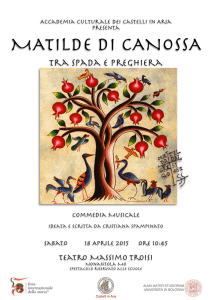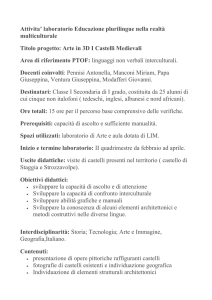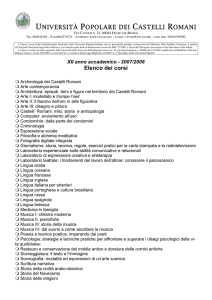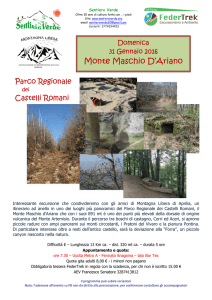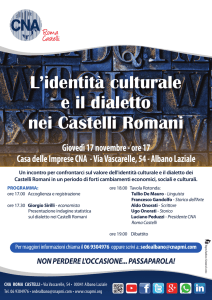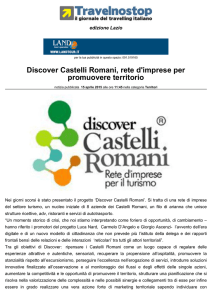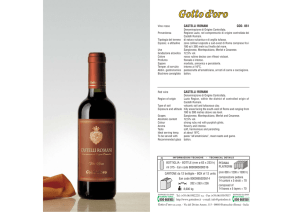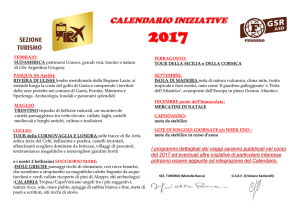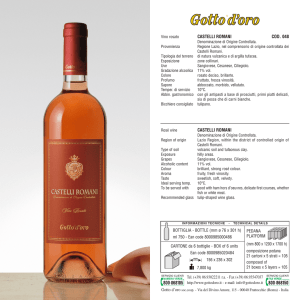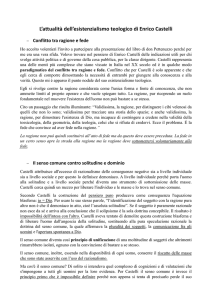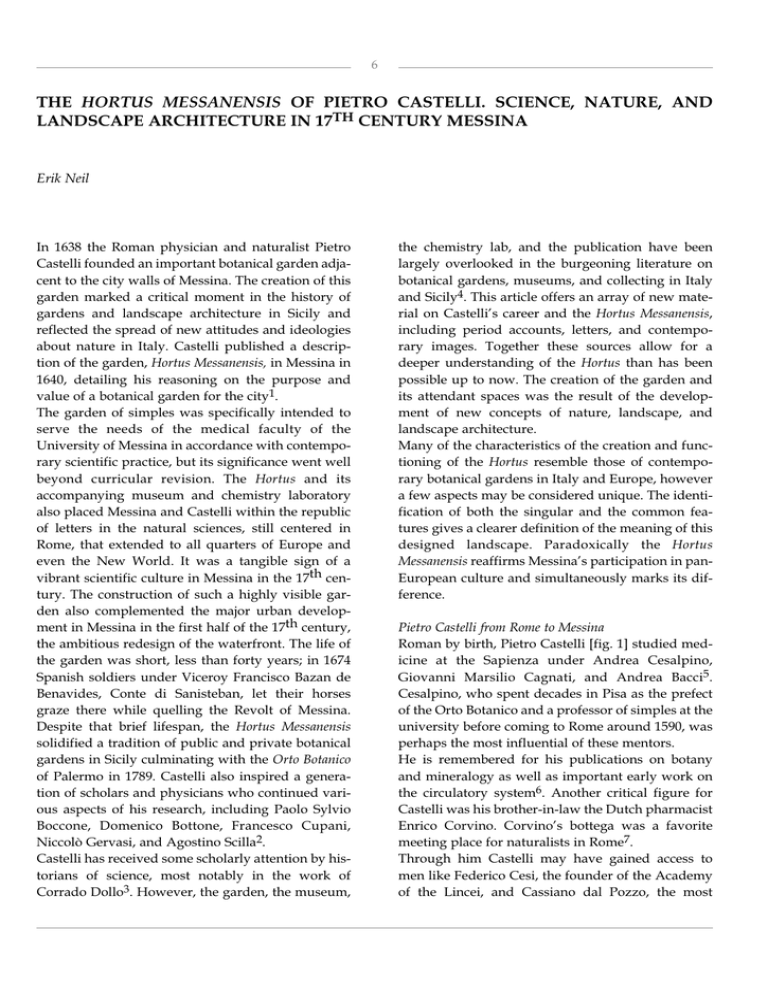
6
THE HORTUS MESSANENSIS OF PIETRO CASTELLI. SCIENCE, NATURE, AND
LANDSCAPE ARCHITECTURE IN 17TH CENTURY MESSINA
Erik Neil
In 1638 the Roman physician and naturalist Pietro
Castelli founded an important botanical garden adjacent to the city walls of Messina. The creation of this
garden marked a critical moment in the history of
gardens and landscape architecture in Sicily and
reflected the spread of new attitudes and ideologies
about nature in Italy. Castelli published a description of the garden, Hortus Messanensis, in Messina in
1640, detailing his reasoning on the purpose and
value of a botanical garden for the city1.
The garden of simples was specifically intended to
serve the needs of the medical faculty of the
University of Messina in accordance with contemporary scientific practice, but its significance went well
beyond curricular revision. The Hortus and its
accompanying museum and chemistry laboratory
also placed Messina and Castelli within the republic
of letters in the natural sciences, still centered in
Rome, that extended to all quarters of Europe and
even the New World. It was a tangible sign of a
vibrant scientific culture in Messina in the 17th century. The construction of such a highly visible garden also complemented the major urban development in Messina in the first half of the 17th century,
the ambitious redesign of the waterfront. The life of
the garden was short, less than forty years; in 1674
Spanish soldiers under Viceroy Francisco Bazan de
Benavides, Conte di Sanisteban, let their horses
graze there while quelling the Revolt of Messina.
Despite that brief lifespan, the Hortus Messanensis
solidified a tradition of public and private botanical
gardens in Sicily culminating with the Orto Botanico
of Palermo in 1789. Castelli also inspired a generation of scholars and physicians who continued various aspects of his research, including Paolo Sylvio
Boccone, Domenico Bottone, Francesco Cupani,
Niccolò Gervasi, and Agostino Scilla2.
Castelli has received some scholarly attention by historians of science, most notably in the work of
Corrado Dollo3. However, the garden, the museum,
the chemistry lab, and the publication have been
largely overlooked in the burgeoning literature on
botanical gardens, museums, and collecting in Italy
and Sicily4. This article offers an array of new material on Castelli’s career and the Hortus Messanensis,
including period accounts, letters, and contemporary images. Together these sources allow for a
deeper understanding of the Hortus than has been
possible up to now. The creation of the garden and
its attendant spaces was the result of the development of new concepts of nature, landscape, and
landscape architecture.
Many of the characteristics of the creation and functioning of the Hortus resemble those of contemporary botanical gardens in Italy and Europe, however
a few aspects may be considered unique. The identification of both the singular and the common features gives a clearer definition of the meaning of this
designed landscape. Paradoxically the Hortus
Messanensis reaffirms Messina’s participation in panEuropean culture and simultaneously marks its difference.
Pietro Castelli from Rome to Messina
Roman by birth, Pietro Castelli [fig. 1] studied medicine at the Sapienza under Andrea Cesalpino,
Giovanni Marsilio Cagnati, and Andrea Bacci5.
Cesalpino, who spent decades in Pisa as the prefect
of the Orto Botanico and a professor of simples at the
university before coming to Rome around 1590, was
perhaps the most influential of these mentors.
He is remembered for his publications on botany
and mineralogy as well as important early work on
the circulatory system6. Another critical figure for
Castelli was his brother-in-law the Dutch pharmacist
Enrico Corvino. Corvino’s bottega was a favorite
meeting place for naturalists in Rome7.
Through him Castelli may have gained access to
men like Federico Cesi, the founder of the Academy
of the Lincei, and Cassiano dal Pozzo, the most
7
Fig. 1. Pietro Castelli (Courtesy National Library of Medicine,
Bethesda, Maryland).
prominent figure in the intellectual-aristocratic culture of mid-17th century Rome8.
Although there is some disagreement about the precise sequence of events, after Castelli received his
diploma in 1594, he lectured outside the university
and practiced medicine. At an undetermined
moment Castelli became the personal physician of
Lelio Biscia (1573-1638). Biscia was a minor patron of
the arts and played an important role in the urban
planning of Rome during the pontificate of Paul V.
He was appointed cardinal by Urban VIII9.
He commissioned Castelli to write a description of
the eruption of Vesuvius, Incendio Del Monte Vesuvio
(Rome 1632), based upon others’ first-hand accounts
and earlier published works10. Biscia also arranged a
place for the physician at the University of Padua, a
privilege Castelli was pleased to recall: «poi per
accrescermi gloria & honore havermi procurato con
l’Ecc. Alvigi Contarini Oratore della Serenissima
Republica di Venetia appresso la santità di N. S.
Papa Urbano VIII un luogo nel fioritissimo studio di
Padova con amplo stipendio…»11.
The date, duration, and precise nature of Castelli’s
activities in Padua are all unclear. But considering
his interests and experiences he likely had extensive
contact with the famous botanical gardens. As will
be discussed below, the Orto of Padua was one of the
models that Castelli followed when creating the
Hortus Messanensis.
By 1625-26 Castelli was also under the nominal protection of Cardinal Francesco Barberini. Through
Cardinal Barberini, Castelli was named a university
professor12. He became a lettore of Simples. This field
combined aspects of botany and chemistry. One contemporary author described it: «Simpling is an art
which teacheth the knowledge of all Druggs and
Physicall Ingredients, but especially of Plants, their
Divisions, Definitions, Differences, Descriptions,
Places, Names, Times, Vertues, Uses, Temperatures,
& Signatures»13.
It was a basic part of medical training and Castelli, as
a student of Cesalpino, would have been considered
well prepared in the field. Only in 1629, after the
death of Giovanni Faber, he did assume the post of
publico Semplicista of the Orti Vaticani14.
However a bitter letter written several years later by
Castelli to Dal Pozzo suggests that he was dissatisfied with his position. «[E]ssendo io in Roma lettor
de Semplici, ero senza Horto, hora ho l’horto e non
la lettura de semplici, leggendo io nello studio la
Prattica e l’Anotomia...»15. It can be inferred from
the letter that Castelli was passed over for a preferred post that instead went to Tobia Aldini. This
may help explain why he left Rome and also may
shed some light on an odd aspect of Castelli’s publishing career. A well-known description of the
Farnese gardens on the Palatine Hill, the Exactissima
descriptio rariorum quarundam plantarum, que continentur Rome in Horto Farnesiano gives Aldini as an
author [fig. 2]. However it has long been suggested
that Pietro Castelli had a significant role in the publication and was perhaps the actual author16. The
reasons or motivations for such an arrangement
remain unclear. Aldini had contributed a letter to
Castelli’s Discorso della duratione delli medicamenti
(Rome 1621) suggesting a previous professional relationship if not friendship. Additionally one contemporary account suggests that Cardinal Biscia was
increasingly out of favor with the Barberini by the
1630s17. If Castelli felt the environment in Rome was
not conducive to his professional advancement he
Lexicon - n. 1/2005
8
Fig. 2. Exactissima descriptio..., Rome 1625 (Courtesy National
Library of Medicine, Bethesda, Maryland).
Fig. 3. Hortus Messanensis titlepage (Courtesy National Library
of Medicine, Bethesda, Maryland).
might have been more willing to accept a lucrative
post in Messina, a place he later described as «questo
estremo d’italia, e d’Europa»18. Furthermore he may
have received some encouragement from Cassiano
who was apparently very curious about Mt. Etna.
Messina did offer new challenges, an excellent
salary, and the freedom to pursue his interests.
When approached he accepted an offer from the
Senate of Messina to take a post on the faculty of
medicine.
worthwhile. The University itself was in some turmoil over its governance in these years as the municipal authorities and Jesuits fought for control19.
Ultimately the Senate would assert its authority, but
not until 1641, after the creation of the garden. This
situation may have both delayed the completion of
the garden and influenced its particular design.
A wealth of information on the garden comes from
Castelli’s description and index published as Hortus
Messanensis in 1640. The book opens with two etched
illustrations [figs. 3-4]. In the first, a figure of Flora
holding a scroll with the author’s name and the title
is showered with petals by a quartet of putti, two of
them are holding cornucopias half-full with flowers.
The second illustration is the stemma of Cardinal
Francesco Barberini, followed by the title page. The
text is then divided into four distinct sections: the
dedication, a note to gentle readers, a note to his fellow scientists (in Latin), and finally the index of
plants (also in Latin) followed by fifteen separate
Hortus Messanensis
Considering Castelli’s experience in Rome and
Padua and his expertise with simples it follows logically that he immediately pushed for the creation of
a botanical garden in Messina. In the Spring of 1638,
after several appeals to the Senate, his desire found
support. The delay in the creation was the result of
several factors but ultimately it was a matter of convincing the Senators that such an appropriation was
9
Fig. 4. Hortus Messanensis frontispiece (Courtesy National
Library of Medicine, Bethesda, Maryland).
plates. The plates are each devoted to one of the
fourteen hortuli, or beds, plus one presenting the
total disposition of the garden [fig. 5]20. Each section
of the publication is revealing in its own way. The
dedication to Cardinal Barberini is laden with the
hope, unstated in the brief passage, but clear from
his letters, that Castelli might be called back to
Rome. In a 1639 letter to his friend Marco Severino in
Naples he described the difficulties with the Jesuits
and the departure of a professor of law for Padua.
Then in the tone that seems to run through all his
correspondence he wrote of his plan to create the
“Horto” and lamented: «[L]o farò stampare in breve,
acciò per il Mondo si sappia che ho fatto l’Horto in
Messina: poi spero, che Dio, per sua Misericordia mi
liberarà da questo purgatorio per il paradiso di studio più studioso»21.
Four years later when he thought there might be an
open position he pleaded his case in a letter to
Cassiano dal Pozzo. He asked for Cassiano’s inter-
vention with Cardinal Barberini and Monsignor
(Tiberio?) Cenci. «Hora prego V.S. Ill[ustrissi]ma
proponere à S[ua] E[ccellen]za et à Mons. Cenci me
per il detto Horto, ne possono dire, che io non me ne
intenda; perche vedranno, se sò de semplici, e far
Horti, dal Horto Mesinese che hò qui fatto, et in
stampa dedicata à S[u]a Eminenza, il quale quando
mio Nepote glilo presentò, gli disse che sarebbe
venuto occasione di favorirmi. Hora è il tempo, che
V. S. Ill.mo mi può favorire, e farmi tornare à
Roma...»22.
In this case however the dedication did not achieve
its intended result; the call to Rome never came.
In his note to the readers, Alli Benigni Lettori, Castelli
gives another, more reasoned, account of his motives
and intentions. Exactly whom he perceives to be his
readers is a crucial point. Castelli directs the greater
part of the essay toward the elites of Messina who
have given him the opportunity and the funds to create the garden. The text is rich with information
about the history of botany, gardens, and the history
of the study of the natural sciences in Italy. Castelli
places himself in the company of the most distinguished physicians and natural scientists of the 16th
and early 17th centuries. The note to the readers is
really an essay on the value and ideology of the
botanical garden. Castelli considers an array of
issues including civic pride, professional practice,
public welfare, and social status. His consciousness
of his patrons’ concerns is evident in the way that he
taps into sentiments regarding the prestige of the
city. His specific patrons would have been the six
Senators who consented to his request and, more
generally, the ruling class of merchants, aristocrats,
and ecclesiastics. Castelli praises the Messinese for
the creation of the University or Studio. This he
deems an appropriate imitation of ancient Athens.
Similar institutions, he points out, were also features
of great cities in Italy such as: Rome, Padua, Bologna,
Pisa, Mantua, Parma, Turin, Naples, and Catania. He
then lists university towns across Europe including
Basel, Heidelberg, Wittenberg, Leiden, Paris,
Montpellier, Salamanca and many others. He continues on the theme of civic magnificence but moves
toward other related justifications.
The structure of his argument for a botanical garden
is logical, taxonomic even. He proceeds from ancient
to modern and from general to specific. A great city
needs a university, which in turn must have a facul-
Lexicon - n. 1/2005
10
Fig. 5. Fourteen hortuli (Courtesy National Library of Medicine, Bethesda, Maryland).
ty of Medicine. The proper education in Medicine
requires the study of simples. To study simples you
must have a botanical garden. His intention is to
demonstrate alli Idioti how necessary and useful a
garden of simples is for the University and how the
city can benefit and to laud the Senate of Messina for
giving the space and the funds. The encomiums may
seem superfluous or extreme but when he praises
Messina for: «... il sito, per le ricchezze, e mercantie,
per la nobilta, a valore de gl’antenati, per la fedelta a
suoi Regi, per la forma del governo, per lo primato,
e titolo di capo di questo Regno, e per singolari privilegi Reali, Papali, e Divini...,»23 he is touching on
issues critical for his patrons. A botanical garden,
like the University, is a feature that gives Messina
greater stature, especially in comparison with its
rival Palermo (and to a lesser extent Catania). In fact
a botanical garden of this sort was still relatively rare
in Italy and Europe. Again Castelli provides a list of
distinguished cities: Rome, Padua, Pisa, Bologna,
Perugia, Montpelier, and Leiden that boast such
spaces. Furthermore he points out to the Idioti that
the Pope, the Serenissima Republica, the Grand Duke
(of Tuscany), and other princes have seen fit to
aggiongere anco l’Horto to their universities.
A second argument subsequently unfolds. He
returns to the idea that a garden of simples is necessary for the proper education of doctors. To the
assertion that students might learn the material from
illustrated books he responds: «...non si fà il bon
Semplicista del vedere l’herbe dipinte; ma dalle
parole del mastro semplicista, dalla presenza della
pianta, e dal vederla più volte in varie stagioni,
nascente adulta, con fiori, con frutti, e con semi.
Nemo Nauta ex libris»24.
He emphasizes the need for the physician to see,
smell, taste, and feel the plant. To this modern “scientific” conception of direct observation he offers the
support of Galen and Pliny. The alternative, as
Castelli sees it, is that without the proper training of
doctors and pharmacists, we would have to rely on
the unprepared “Erbarolo” or “Droghiero” or
“Mercante” to identify and gather the plants for
medications. Thus the life of a man or a prince might
lie nelle mani d’un Villano, che non sà leggere.
After that disturbing scenario, Castelli tries to strike
a more positive note but slides back into the negative. The Hortus will provide the infirm with:
«alcune herbe fresche, e verdeggianti. [P]osciache
molto piu si deve stimare l’herba di poco colta, di
quella, che è seccata, corrotta, stata esposta alle
ingiurrie delle mosche, alli ragni, al vento, al polvere»25. Also, in Castelli’s view, plants that sprout in
the environment of Messina will be better suited to
the Messinese.
In the final pages of the essay, Castelli considers a
third point, the pleasure and nobility of the garden.
In effect he argues for a public garden; a remarkable
consideration at this date. «Alla necessita, & utilita
della costruttione del detto Horto aggiongeremo la
delettatione, che ne prende il popolo tutto per esser
d’ogni intorno visibile, ed varij colori de fiori quasi
dipinto tutto l’anno. [D]i molte sorgenti Fonti, e
diversi lavori ornato con ample, e nitide strade, che
a riguardanti porgono diletto, e ammiratione. [D]i
fuori mirandolo dei ponti, e de le mura. Ma se di
dentro vi piacera mirarlo, circuirlo, e considerarlo,
con gl’occhi, con li passi, con la mente, si godera gli
11
suaui Arabi odori, le varie forme delle piante, i vaghi
colori de fiori»26. From a discussion of the public
pleasures of the garden Castelli makes a transition,
with the help of Pliny and Tacitus, to a discourse on
the cultivation of gardens as a royal pastime. This
variation, with a more acute appeal to social status
and elitism, returns to his earlier arguments for the
Hortus as a mark of civic distinction. «Ecco (amici
Lettori) la professione di semplici non è di Villani,
non è di quei Spetiali, e Medici, che riputandosene
indegni la lasciano; ma da Principi, da Re, da gran
Filosofi, & huomini Illustri»27.
This point relates to a certain ideal of agriculture as
an aristocratic pastime propounded in the Villa
books of the mid-16th century28. It is indicative of
the change in attitudes from 1550 to 1640 that the
ideology is nimbly altered or expanded to include
the study of nature and other scientific pursuits.
The third text section, Herbarum Scientiæ Studiosis, is
clearly directed to fellow botanists across Europe.
He again identifies the traditions of natural history
and the study of plants going back to the ancients
Galen and Pliny but also Avicenna and then moderns like Leonhart Fuchs and Castore Durante. He
compares and contrasts his own theoretical
approach to those of botanists such as Adam
Zaluzansky, Antonio Brasavola, and Caspar Bauhin.
This is obviously a discussion for specialists. He reiterates his debt to his mentor Andrea Cesalpino as
well as his brother-in-law, Enrico Corvino. Castelli
explains that he has divided his garden into fourteen
parterres named for the apostles, plus Saints Paul
and Placido (one parterre together), and the Virgin
Mary, the protectress of the garden and the city of
Messina. The divisions of the plants do not, however, depend on any religious symbolism. Rather the
ordering is based on seminal and vascular systems.
Mosses and aquatic plants are arranged around the
fountains and interspersed throughout the garden.
Form & Content
Documents published a century ago by Giuseppe
Arenaprima reveal the dates of payment and construction activity as well as the presence of the architect or Ingignerj of Messina, Giovanni Angelo
Ponzello in 1638-3929. As architect and engineer for
the city Ponzello would have been involved in any
constructions affecting the public structures. His
most significant project, the redesign of the water-
front or Palazzata, unified the façades of all the buildings facing the port. This gave Messina an ordered
yet dramatic face. The creation of the Hortus
Messanensis can be interpreted as an extension of this
project for the city. It too provided an image of order
and beauty to the city.
The Senate offered Castelli a space in the moat outside the walls. In a novel arrangement, two preexisting bridges, the Ponte di Porta Imperiale and the Ponte
della Porta della Maddalena were incorporated in the
design. The spaces below the bridges were adapted
to accommodate a laboratory, a museum, and a
chapel. The bridges were also ideal for viewing the
Hortus. Even though it was enclosed, the public
could still enjoy the garden. The space was 270 canne
long by 24 canne wide (roughly 580 x 50 meters). This
was a considerable area. A small perspective view
from Castelli’s Opobalsamum Triumphans gives some
idea of the layout and the relationship between the
bridges, the garden, and the wall [fig. 6]30. It seems
to indicate that a significant portion of the garden
Fig. 6. Opobalsamo Triumphans, view of the Hortus (Courtesy
National Library of Medicine, Bethesda, Maryland).
Lexicon - n. 1/2005
12
toward the rear was not formally arranged. The print
is as symbolic as it is topographical: a tree (for balsam?) rises from the garden with seven escutcheons
bearing lions, crosses, and castles, symbols respectively of Messina, the church, and Castelli himself.
The oblong space designated by the Senate determined the overall form. It may be assumed that
Ponzello directed the work to secure the perimeter of
the garden, install the fountains, and perhaps construct or fashion spaces for the chemistry lab, museum, and chapel that are only briefly mentioned by
the naturalist and recorded in visitors’ accounts.
However the internal design and layout of the fourteen hortuli or parterres most likely came from
Castelli.
The unusual, not to say unique, naming of the flower
beds for the apostles, a saint, and the Virgin Mary
may be a nod toward ecclesiastical authorities, either
the Jesuits, who still officially administered the
University, or perhaps the desired patron Cardinal
Barberini, to whom the Hortus Messanensis is dedicated. From his letters to Cassiano dal Pozzo, it is
clear that Castelli understood his position and obligations within the dynamic of patronage31.
The parterres, although varied, all develop out of the
idea of inscribing a circle within a square. Aside
from any cosmological interpretations the plans suggest that Castelli sought to emulate the format of
existing botanical gardens. In one of his letters to
Cassiano from 1638 he mentioned that, «questi signori si sono risoluti di fare un horto di semplici `a
gara di quello di Padova»32. In the Hortus
Messanensis he affirmed that he had seen the published plans Disegno of some of the important botanical gardens in Europe. Considering the very close
formal similarities it appears certain that he looked
at Gerolamo Porro’s L’Horto dei semplici di Padova
published in Venice in 1591. Castelli’s plan for garden Sanctus Bartholomæus VIIII is almost exactly the
same as the plan for the spaldo secondo in Porro’s
work [figs. 7- 8-9]. Of course he knew the layout of
the Paduan from first-hand experience. In turn, as
Margherita Azzi Visentini has shown, the Paduan
plans depended upon designs published by
Sebastiano Serlio in Book IV of his Regole Generale di
Architettura first published in Venice in 1537 [fig.
10]33. A variation appear in a late 16th century manuscript regarding the Orto Botanico Pisano34. The
arrangement with the fountain at the center of the
Fig. 7. Hortulo Sanctus Petrus (Courtesy National Library of
Medicine, Bethesda, Maryland).
Fig. 8. Hortulo Sanctus Bartholomæus VIIII (Courtesy National
Library of Medicine, Bethesda, Maryland).
13
circle/square also appears in Falda’s mid-17th century image of the garden of simples at the Vatican
[fig. 11]35. The form became a topos of botanical garden design, a sign, perhaps, of the desire for ordering and classification that was behind the creation of
all these spaces. Understanding that this was the
case it can still be asserted that Castelli wanted to
equate himself and his endeavor with the Paduan
model.
Microcosm & Wunderkammer
Within these 14 beds he tried to recreate the world
that was in his grasp. This included not only his
immediate surroundings, but also by extension the
environment of his brother-in-law and semplicista
Enrico Corvino in Rome and potentially any of his
correspondents across Europe and the New World.
Already in the 16th century Aldrovandi recognized
that botanic gardens were an important means of
giving order to the World, especially the New
World36.
Speaking of the botanic garden of Pisa, Lucia
Tongiorgi Tomasi has noted: «Separated from the
urban landscape by high walls and characterised by
a precise ground plan, it came to assume the physiognomy of a genuine microcosm, a well-ordered
model of the universe in which heaven and earth
were founded in closely knit implications of perennial rebirth»37.
This description is applicable to most botanical gardens in Europe in the early modern period, and it
generally fits the Hortus Messanensis. Certainly this
was the theme followed by the historian Placido
Reina in his 1658 description of Messina. Reina, a
friend and colleague of Castelli, noted that «il terreno Zancleo disposto a produrre qualunque altra
pianta, che sia così di quelle, che servono all uso
della Medicina, come di quelle, che co’vaghi, ed
odoriferi fiori vagliono a ricreare I sensi. Ne parlo
delle piante nostrali solamente, ma delle straniere
ancora, perche I semi d’esse da qualsivoglia lontan
paese portati mettono quì, e maravigliosamente germogliano»38.
He then inserted a letter written by Castelli to the
Roman physician Domenico Panaroli detailing the
range of plants in the Hortus. Castelli begins with the
citrus fruits, limes, lemons, and oranges followed by
three dozen or so other examples including a variety
of tulips, roses, jasmine, and hyacinths. Castelli
Fig. 9. Plan from Porro's Hortus Patavinus (Courtesy National
Library of Medicine, Bethesda, Maryland).
Fig. 10. Serlio garden plan (Courtesy of Special Collections of
Howard-Tilton Memorial Library, Tulane University).
Lexicon - n. 1/2005
14
Fig. 11. Detail from Falda Giardini di Roma (Courtesy of the
author).
emphasizes his ability to grow plants from India,
Arabia, America, Egypt, China, Persia Spain,
Belgium, Holland, Peru, and Turkey.
Landscape
Yet what made the collections of Messina important
in the eyes of 17th century scientists and connoisseurs was not their similarity to peninsular exemplars but rather their divergence. Messina had things
to offer that could not be found elsewhere39. What
may be specific to the Hortus Messanensis is its location in Sicily with its distinctive landscape (above all
Mt. Etna), flora, and fauna. According to various
accounts, the ground itself regularly offered up
objects such as ancient coins, fossils, and volcanic
rocks to the hands of eager collectors. Even the
waters around Messina and the west coast of Sicily
held special interest for the swordfish, sharks, and
flying fish.
Already in 1496 Pietro Bembo made the link between
Mt. Etna and the collection of rarities. In his De Aetna
he mentioned the ruins of Taormina and then noted:
«In fact, Greek coins are unearthed by accident
everywhere». Later in the same essay he describes
his ascent of Mt. Etna and the various geological
phenomena. His interest was so great that he
«brought two rocks back to Messina when they had
cooled off and could be picked up by hand, with
some of their sulphur left»40. The fascination with
Etna would only build in the next 130 years.
Castelli had an intimate knowledge of the volcano
and at one point considered writing about it as he
had already written on Vesuvius. He may even have
had a role in the creation of one of the most impres-
sive publications on volcanology ever produced,
Athanasius
Kircher’s
Mundus
Subterraneus
(Amsterdam 1664-65)41.
In his letter of March 3, 1638 to Cassiano dal Pozzo,
Castelli first mentions the ritorno del P. Atanasio à
Roma42. This is certainly Athanasius Kircher who
was just concluding his visit to Malta and Sicily in
that month43. The familiar tone suggests that Castelli
knew Kircher, which, although undocumented,
seems more than plausible considering their time in
Rome, their shared interests, and their ties to the
Barberini circle. Castelli’s Incendio del Monte Vesuvio
would have made him a recognized authority on the
topic of volcanoes.
The letter goes on to describe Castelli’s first
encounter with Etna and her environment. He seems
to be responding to Cassiano’s interests: «...il passato
Agosto ascesi al Monte Aetna per darlo compagno al
mio Vesuvio; mà trovai presente più difficultà in
questo, che trovassi assente in quello, et havendo
descritto, disegnato, e bon considerato quanto mi è
occorso vedere, non hò hauto compita sodisfattione:
perciò mi sono risoluto di tornarvi questa estate, e
considerare il monte dall’altra parte»44.
A subsequent letter from June, 1638 again mentions
his previous ascent and reiterates his attention to
record all the particulars of the volcano. In the first
visit he had already collected some stones and now
he will also collect plants for the botanical garden
that had been approved by the Senate. «Il
Mongibello sarà da me investigato con ogni diligenza. L’anno passato dove arrivavo andavo descrivendo le piante, che vedevo andavo disegnando spesso
li siti, e le figure del Monte, misuravo ogni cosa, e di
punto in punto andavo descrivendo le piante, che
vedevo, raccoglievo i sassi, come anco hò fatto dell’altri monti, che li ritrovo tutti di diversa manera.
[D]elli diaspri investigarò qualche cosa, che à punto
hò in casa da 3 dozzine di manichi di Cortelli di
diaspro belli, che un mercante me li hà dati in consegna, non tralasciarò di parlare del bitume, del succino, delli Coralli, del Anacardo, e di molte altre cose
di quest’Isola. [S]arò piu curioso per l’avvenire;
perche andarò più attorno; poiche questi signori si
sono risoluti di fare un horto di semplici à gara di
quello di Padova, e mi bisognerà circuire queste
montagne per questa occasione»45.
Castelli’s trips to collect Etnean simples are recorded
in a book by apothecary Giovanni Domenico
15
Cardullo, Teriaco d’Andromaco. Cardullo describes
the various ingredients for the theriac, in few cases
he recalls Castelli’s activities gathering plants such
as camedrio and sesali (sesame): «Camedrio… quale
alle radici di Mongibello verso Castiglione il Dottor
Castelli andando al monte questo Agosto haveva
trovato copiosamente, e giudicata perfetta… il Prior
Castelli ha trovato assai del nostro Sesali, nelle
colline sotto il Monte Etna verso Castiglione, e
Linguagrossa 20 miglia discosta dal mare, questo
mese d’Agosto, quando ando à veder la Montagna
con il diligente, e peritissimo Spetiale di Francaviglia
Girolamo Cardo, nella cognitione de semplici anco
molto esercitato, e curioso… fruttice tanto copioso
per la Sicilia, che da Taurmina insino alla Motta
(Terra del signor Marchese Don Antonio Martiano
gentilissimo Cavallier Messinese, dal quale nel viaggio a Mongibello il nostro Pietro Castelli ricevè molti
favori)»46.
Although Castelli would actively seek plants from
all over the world, the Etnean flora made the Hortus
Messanensis unique. The garden was an attraction for
a number of European visitors in the 17th century
including some prominent naturalists such as the
Dane, Thomas Bartholin, and the Englishmen
Frances Willoughby, John Ray, and Phillip Skippon.
Each of them included descriptions of their experiences in Messina in later published work. Skippon,
offers this account of a May 1664 visit to the Hortus:
«We visited Dr. Jo. Petrus Corvinus, Nephew to Dr.
Petrus Castellus Romanus the famous physician,
who led us thro’ a subterraneous passage from his
house to the city ditch; which being dry, is allowed
by the Messinese for a Physick garden; it is of good
length and breadth. Castellus was the first botanick
professor here; he divided the garden into 12 quarters, called by the apostles’ names. Under one of the
city bridges is a school where botanick lectures are
read, and under another bridge is a room where
skeletons of animals are preserved. Corvinus shew’d
us his study left him by his uncle, who in two quarto volumes, described in painting and writing several insects, which Corvinus confessed himself not
able to be at the charge of printing»47.
This testimony reveals that the garden survived
intact through the end of Castelli’s life. For those
curious about Sicily and the natural world, the
Hortus Messanensis, was an essential stop.
In Rome Pietro Castelli had been part of a network of
scientists and aristocrats who were changing the
approach to the study of the natural world. When he
arrived in Messina in 1635, that scientific attitude
had not yet taken hold on the island. Like Del Duca
and Montorsoli and even Ponzello, he brought the
newest Italian ideas to Messina. Initially, as his letters attest, he felt intellectually and physically isolated. However, in the course of twenty-five years a
transformation took place and by the time of his
death in 1661 Castelli might have justifiably claimed
success. He enjoyed the title of Conte Palatino and
an ample salary. Perhaps more importantly, he had
been the harbinger of a new ideology of nature that
emphasized rigorous investigation of all aspects of
the world. More than any discovery, Castelli’s legacy would be realized in the next generation of
Sicilian naturalists (and artists). Most of them had
been his students: Boccone, Bottone, Cupani,
Gervasi, Scilla. They carried his approach to other
parts of Sicily and in the cases of Boccone, Bottone,
and Scilla to Italy and Europe as well. Messina was
no longer just an importer of expertise but also an
exporter. Castelli may not deserve all the credit for
this transformation but he does deserve some.
In the decade and a half after Castelli’s death and
before the revolution in Messina, the Hortus
Messanensis continued to serve its intended purpose
as a place for research and teaching. Significantly it
may be linked to some of the discoveries in plant
structure published by Marcello Malpighi who
assumed Castelli’s post at the university48. Despite
its destruction, a memory of the place lived on, especially in and around Palermo where Cupani and
Gervasi created important botanical gardens.
While it has not generally been recognized or
emphasized, the Hortus Messanensis was a key model
for the much better known Orto Botanico and the
Villa Giulia of Palermo created in 178949. The two
gardens bracket an intellectual era. Both were placed
on reclaimed territory at the edge of the city near a
thoroughfare. Thus they were tangible symbols of
civic beneficence. They both reflect an attitude that
approached the landscape as a place of wonder
awaiting examination and classification. As public
spaces they were also products of a culture of display and theatricality. They were showpieces for
their respective cities, combinations of the ideologies
of investigative science, public display, and civic
identity.
Lexicon - n. 1/2005
16
Appendix I
Letters from Pietro Castelli to Cassiano dal Pozzo, Biblioteca dell’Accademia Nazionale dei Lincei, Roma, Archivio Dal Pozzo, ms
XII (10).
Lettere 5-12, cc. 8r-19r
*As cited in Anna Nicolò, Il Carteggio di Cassiano dal Pozzo, Catalago (Città di Castello 1991) 42.
(1)
12 Aprile 1635
Ill.mo sig,re
Son giunto Dio gratia à salvamento in Messina se bene con travagliato viaggio, e tempeste di Mare, e comincio à trovare in questi
ss.ri una viva ratificat.ne delle cortezze promessemi in Roma. So, che son tanto ser. di V.S. Ill.ri ho stimato mio debito fargline(?)
conto, e fargli insieme sapere, che hà in Messina chi può commandare assolutamente. Di che la supp.co(?) non men che di offerir,
se non lo stimerà ardine (ordine?) all’Eminent.mo Patrone quanto potrà mai valere(?) da queste parti l’humiliss.ma servitù mia, affinche honorata da commandi dell’E. S.a io possa totalmente colmare la mia sodisfatt.e Et(?) a V.S. bagio per fare di tutto cuore le mani.
di Messina li 12 d’Aprile 1635
Devot, Ser.e
Pietro Castelli
(2)
3 Marzo 1638
Ill.mo Sig,re mio et Pat.ne Ill.mo
Il ritorno del P. Atanasio* à Roma incita me ancora à ritornare alla patria, non già con il corpo, che stà qui legato dalla bona gratia
di questi S.S. alli quali è gradito la mia servitù; mà con l’animo, e con le lettere significatrici dell’affetto interno, e del mio gran desiderio d’esser degno di qualche commandamento di V. S. Ill.mo alla quale, si per i meriti proprij, come anco per le gratie altre volte
ricevute, sono io devotissimo, et in perpetuo obligato. Et se per esser io in questo estremo d’Italia, sono quasi fuori del commercio
humano, non dimeno vorrei in qualche parte mostrarmi huomo, et anchor vivo: onde il passato Agosto ascesi al Monte Aetna per
darlo compagno al mio Vesuvio**; mà trovai presente più difficultà in questo, che trovassi assente in quello, et havendo descritto,
disegnato, e bon considerato quanto mi è occorso vedere, non hò hauto compita sodisfattione: perciò mi sono risoluto di tornarvi
questa estate, e considerare il monte dall’altra parte. spero da Dio hora sanità per poter affaticare, e gratia di potere doppo qualchè
anni venire à riposarmi à Roma, e poter servire i miei padroni: fra tanto prego V.S. à non cancellare dal numero delli suoi servitori;
nel quale una volta per sua gratia mi haveva posto, et ricordandomi humilissimo, et devot.mo ser.e dell’Eminent.mo Padrone, al
quale fa profond.ma riverenza, et à V.S. Ill.mo affetuosamente bagio le mani da Messina li 3 di Marzo 1638
Obligat.mo Serv.e
Pietro Castelli
*Athanasius Kircher
**P. Castelli, Incendio del Monte Vesuvio (Roma 1632)
(3)
Ho hauto ardire d’inviare questo mio rozzo libretto (hiena odorata) a V. S. Ill.ma non che lo riputi degno di pervenire alle sue mani
ma perche era debito mio di restituire alli Padroni il suo, havendo io ricevuto dalla benignità di V.S. Ill.ma l’animale morto, et immaginandomi, che non li sia per esser discaro la memoria che io tengo delli benefitij da lei ricevuti, me li hò voluto ricordare obligatissimo servitore, pregandola à conservarmi nel numero delli suoi clienti. Il Mongibello sarà da me investigato con ogni diligenza.
L’anno passato dove arrivavo andavo descrivendo le piante, che vedevo andavo disegnando spesso li siti, e le figure del Monte,
misuravo ogni cosa, e di punto in punto andavo descrivendo le piante, che vedevo, raccogliavo i sassi, come anco hò fatto dell’altri
monti, che li ritrovo tutti di diversa minera. [D]elli diaspri investigarò qualche cosa, che à punto hò in casa da 3 dozzine di manichi
di Cortelli(?) di diaspro belli, che un mercante me li hà dati in consegna, non tralasciarò di parlare del bitume, del succino, delli
Coralli, del Anacardo, e di molte altre cose di quest’Isola. [S]arò piu curioso per l’avvenire; perche andarò più attorno; poiche questi signori si sono risoluti di fare un horto di semplici `a gara di quello di Padova, e mi bisognerà circuire queste montagne per questa occasione; e se Dio mi farà vita farò quanto potranno le mie deboli forze. [T]ratanto affetuosamente bagiandoli le mani gl’augurarò ogni de—- felicità di Messina li 28 di Giugno 1638
Obligatissimo Servitore
Pietro Castelli
(4)
Mando a V.S. Ill.mo un mio Opobalsamo Trionfante il quale fù cominciato à stamparli a Messina; mà per infortunio dello stampatore, bisognò finirli in Calabria; dove è stato tanto mal trattato di Carattere, carta, e stampatura, che non lo devo divolgare. [P]ure per
mostrare à VSIll.mo il mio devoto animo,gli lo mando tal qual è riceva l’affetto, non l’effetto: perche desideravo di mandarli cosa
compitssima e li b. le mani di Messina li 26 d’Agosto 1640
Aff.Ser.e
Pietro Castelli
17
(5)
Ho inteso quante difficoltà habbia patito il mio libro del Balsamo per havere il publicetur, e quanto sia stato da V.S. Ill.ma favorito.
[S]ono obligato ringraziarli: ma non basta una sola privata lettera, anchorche tutta Retorica per ricompensare tante gratie ricevute;
hò voluto confessare il mio obligo con 500 publiche lettere. So che non ho sodisfatto a quanto devo, mà V.S. Ill.ma accetti il bon
animo, e l’animo diuno, che cerca difendere la verità, sentendo veramente, e che il detto Opobalsamo sia legittimo, e reale onde non
mi hanno potuto movere le grandi offerte (?) della parte contraria,che hò volu—più tosto difendere la verità, che propor il falso (che
pur havere con l’arte sofistica saputo palliare) e guadagnare. Prego V.S. Ill.ma accetti il bon animo, e si ricordi che essendoli antico
servitore li desidero il colmo delle felicità, e quelli honori, che si devono alli meriti di V.S. Ill.ma qual pregi si degni(per gratia) in
mio nome far humilissima riverenza al Emminentissimo Padrone e li b. le m.i di Messina li 25 di Agosto 1640
Aff. servitore
Pietro Castelli
(6)
Mandai a V.S. Ill.ma il mio Opobalsamo trionfante con alcuni fogli mal stampati, che mi vergonavo, che comparissero, l’hò fatto
ristampare e gli lo mando hora, in quanto alla stampa in meglior forma, ne mando una quarantina per lettere alli amici, e cosi nè
verrò mandando dell’altri. [H]ò tardato assai per haverli fatti stampare in Venetia, non potendo qui V.S. Ill.ma accetti il bon animo.
Ho ricevuto il libro di Stefano Gasparo*, quale ho trovato molto debole di dottrina, gl’ho risposto subbito acerbamente; ma pare che
non merita risposta giudicando qui molti dotti, che tocchi tanto leggiero il mio Opobalsamo, che non accada difenderlo, starò aspettando che mi li commanda da Roma tra tanto prego V.S. Ill.ma ricordare la mia humilissima servitù al Eminent.mo Padrone, bagiandoli di core le mani di Messina li X di Xbre 1640
Aff. Se.re
Pietro Castello
*Stefano de Gasparis, Liquoris artificialis pro opobalsamo orientali in conficienda theriaca Romae adhibiti physica oppugnatio... (Roma 1640)
(7)
Mando à V.S. Ill.ma la forma e l’indice delle Piante del Horto Messinese, essendo io in Roma lettor de Semplici, ero senza Horto, hora
ho l’horto e non la lettura de semplici, leggendo io nello studio la Prattica e l’Anotomia, se bene nel Horto insegno i semplici, e la
Chimica havendomi fatto un bellissimo destillatorio, che ristampando l’Horto faro l’aggionta non solo de semplici che stò di giorno
in giorno acquistando; mà anco della mia Officina chimica e de forni che mi hò fatto fare, e poiche Roma non mi vole, e stima un
Tobia* per maggio semplicista, per maggior Chimico, per maggior Cosmografo, e per maggior filosofo e Medico che
Dioscorde,Paracelso. Tolomeo, Aristotele e Galeno quali tutti al suo dire sono ignoranti; dunque Tobia l’Horto, et io il nome di semplicista con solo >(onze ?) 80? Sia ringratiato Dio, qui ne hò mille, e quello di più, che si guadagna nel medicare e ben vero, che piu
volentieri starei in Roma per 300. [B]astami che Roma mi conosca, e fra tanti anch’io ho scritto del Balsamo. e se Roma non mi volse
ne per Teorico ne per Prattico: mà solo per semplice straordinario de leggere le feste e le vacanze. Eccoche qui sono omnia. Medica
prima Teorico, poi Prattico, Notomista, Chimico, e semplicista teorico a prattico. Eccoche è verissimo Nemo Profeta in Patria, un
Romano non e stato degno di leggere in Roma ne Teorica, ne Prattica; ma à Monte rotondo, Fiorenza, Aquila, Spoleto si mi doglio
spesso della mia cattiva sorte ma bisogna per forza haver pazienza. Non dimeno stia pur io in questo estremo d’italia, e d’Europa
pur voglio, che per il Mondo si sappia che son vivo, non cessando dar gran voci, e risonanti bombi con le mie stampe; et hor si preme
il n.o libro de Vomitu accetti V.S. Ill.ma questo picciol dono d’un Horto per regno del grande che vorrei offerirli, e li b. le m.i di
Messina il p.o di Marzo 1641.
Affe.mo Se.re
Pietro Castello
*Tobia Aldini
(8)
Intendo, che l’Eminent.mo Sig.r Card.al Padrone vole fare un Horto publico de semplici per lo studio di Roma, non sò chi prenderà
per lettore de semplici. Et perche il sig. Gio. Benedetto Sinibaldi è stato eletto per lettore in Messina, e lasciarà la lettura di Roma, che
ora de semplici, de quali egli niente sà ne mai hà fatto professione. Hora prego V.S. Ill.ma proponere à S. E.za et à Mons. Cenci me
per il detto Horto, ne possono dire, che io non me ne intenda; perche vedranno, se sò de semplici, e far Horti, dal Horto Mesinese
che hò qui fatto, et in stampa dedicata à S.a Eminenza, il quale quando mio Nepote* glilo presentò, gli disse che sarebbe venuto occasione di favorirmi. Hora è il tempo, che V. S. Ill.mo mi può favorire, e farmi tornare à Roma, che se bene qui sto bene, pure desidero stare in Roma, con la metà dello stipendio che qui hò però prego V.S. Ill.mo quanto sòl, e posso, che si degna dire qualche parola per me, che à tanti oblighi, che li devo aggiongerà questo, che è il maggiore, che li possa dimandare, e con tutto il core li b. le m.
di Messina li 18 di Aprile 1643.
Obligat.o Ser.e
Pietro Castello (*Francesco Corvino?)
Lexicon - n. 1/2005
18
1
2
3
4
5
6
7
8
9
10
11
12
13
14
15
16
17
18
19
20
21
22
23
24
The title page reads: Petri Castelli Romani, Nobilis Messanensis Philosophi, et Medici. In Celeberrimo Mamertinorum Gymnasio Medicina
Practica Profeßoris Primarij. Anatomici Publici Chimiæ extraordinarij interpretis. Atque Academici Horti Simplicium Proto Præfecti, &
Fondatoris. Olim In Romano Archigymnasio Philosophiæ primum, tum Medicinæ, & Simplicium Lectoris. HORTUS MESSANENSIS,
Messanæ, Typis Viduæ Ioannis Francisci Bianco. M.DC.XXXX. Superiorum Permissu.
Some of the botanical gardens following the Hortus Messanensis included the Hortus Catholicus created by Francesco Cupani in
the town of Misilmeri, the garden of Niccolò Gervasi and the Firriato of the Prince of Villafranca, both in Palermo.
C. DOLLO, Modelli scientifici e filosofici nella Sicilia spagnola, Napoli 1984, especially Cap. 5 Tradizionalisti e neoterici a Messina, pp.
138-179; IDEM, Fra tradizione e innovazione, L’insegnamento messinese della medicina e delle scienze nei secoli XVI e XVII, in «Annali di
Storia delle Università Italiane», v. 2, 1998; A. OTTAVIANI, Da Fabio Colonna a Paolo Boccone: momenti della storia della botanica fra
Napoli e Sicilia & O. TRABUCCO, La corrispondenza tra Pietro Castelli e Marco Aurelio Severino, in Filosofia e Scienze nella Sicilia dei Secoli
XVI e XVII, Catania 1996, vol. I, pp. 109-131 & pp. 137-166; A. OTTAVIANI, Nemo Nauta Ex Libris: Pietro Castelli e la scienza botanica
fra Roma e Messina, in «Medicina nei Secoli, Arte e Scienza, Journal of History of Medicine», n.s. v. 12, n.1, 2000, pp. 551-563.
Passing references may be found in L. TONGIORGI TOMASI, Botanical Gardens of the Sixteenth and Seventeenth Centuries, in The
Architecture of Western Gardens, Cambridge MA 1991, pp. 81-82; J. DIXON HUNT, Curiosities to Adorn Cabinets and Gardens, in The
Origins of Museums, Oxford 1985, p. 26; P. FINDLEN, Possessing Nature, Museums, Collecting, and Scientific Culture in Early Modern
Italy, Berkeley 1994, p. 256. However no mention is made of the Hortus in G. PIRRONE, L’Isola del Sole, Architettura dei giardini di
Sicilia, Milano 1994, or T. PUGLIATTI, Le raccolte di meraviglie a Messina nel Seicento, in Wunderkammer siciliana, Napoli 2001, pp. 4753.
Along with the works already cited, see A. DE FERRARI, Pietro Castelli, in Dizionario Biografico degli Italiani (DBI), v. 21, Roma 1978,
pp. 747-751 with references to the important earlier literature. De Ferrari suggests that Castelli’s birth was between 1570 and 1575
but that seems a little early given the dates of his first publications. Castelli dedicates one early work, Discorso della duratione delli
medicamenti tanto semplici quanto composti, Roma 1621, Alli molti illustri signori, Li S.S. Francesco Castelli et Diana de Georgi Padre, &
Madre miei Carissimi.
Ivi, v. 16 pp. 301-303.
Castelli included an Opinione D’Arigo Corvino di Delfo in Olandia, Spetiale in Roma all’insegna dell’Aquila Imperiale in his Discorso della
duratione delli medicamenti. Corvino praises his brother-in-law as an assiduous observer. See also J. CONNORS, Virtuoso Architecture
in Cassiano’s Rome, London 1992, vol. II, p. 23.
Castelli dedicated his Epistola secunda de Helleboro, Roma 1622, to Cassiano. For Castelli’s activity in Rome see A. OTTAVIANI, Da
Fabio Colonna a Paolo Boccone... cit., pp. 139-141; R. PIROTTA and E. CHIOVENDA, Flora Romana, Roma 1900, pp.93–95.
G. MORONI, Dizionario di erudizione storico-ecclesiastica, Roma 1840-79, vol. 5, p. 251; A. SUTHERLAND HARRIS, Andrea Sacchi’s ‘Portrait of a
Cardinal’, «National Gallery of Canada Bulletin», 1969, vol. 14, pp. 9-15, esp. n. 19; J. CONNORS, Biscia, Lelio, in Grove Dictionary of Art,
New York & London 1996, vol. 4, p. 90; L. RICE, The Altars and Altarpieces of New St. Peter’s, Cambridge 1997; E. LINGO, The Greek Manner
and a Christian Canon: François Duquesnoy’s Saint Susanna, in «Art Bulletin», March 2002, 73, 90 n. 94.
Incendio del Monte Vesuvio, Di Pietro Castelli Romano, Lettore nello Studio di Roma già di Filosofia, & hora di Medicina, Nel quale si tratta di tutti gli Luoghi ardenti, delle Differenze delli Fuoghi, Prognostici, e Rimedii, con Metodo distinto, Historico e Filosofico, Roma 1632.
P. CASTELLI, Antidotario Romano, Messina 1638, Dedication to Cardinale Biscia.
Epistolae medicinales Petri Castelli philosophi, ac medici Romani, et in almae vrbis Gymnasio professoris, Roma 1626. In his dedication to
Francesco Barberini he writes : «Tu enim ille es, qui me ad publice legendi munus in Romano Lyceo præ cæteris elegisti…».
W. COLES The Art of Simpling an Introduction to the knowledge and gathering of plants, London 1656, p. 1.
Hortus Messanensis “Alli Begnini Lettori” 4.
Appendix I #7. In Messina Castelli still lectured on simples but in the garden rather than the University.
Exactissima descriptio rariorum quarundam plantarum, que continentur Rome in Horto Farnesiano Tobia Aldino Cesenate Auctore, Roma
1625. See D. COFFIN, Gardens and Gardening in Papal Rome, Princeton 1991, pp. 208-209; P.B. NOCCHI & E. PELLEGRINI, La collezione
botanica del Cardinale Odoardo, in Gli Orti Farnesiani sul Palatino, Roma 1990, 419 with further references.
N. BAROZZI & G. BERCHET, Relazioni degli stati europei lette al senato dagli abasciatori veneti nel secolo decimosettimo, Venezia 1877, Serie
III, vol. 1, p. 278.
Appendix I #7.
O. TRABUCCO, La corrispondenza... cit., pp. 112-113 and Appendix I #.
Until now only the print displaying all fourteen hortuli has been published.
Reprinted in O. TRABUCCO, La corrispondenza... cit., p. 126.
Appendix I #8.
P. CASTELLI, Hortus...,”Alli Benigni Lettori” unnumbered pp. 2-3.
Ivi, p. 5.
19
25
26
27
28
29
30
31
32
33
34
35
36
37
38
39
40
41
42
43
44
45
46
47
48
49
Ivi, p. 5.
Ivi, pp. 6-7.
Ivi, p. 9.
J. ACKERMAN, The Villa, Form and Ideology of Country Houses, Princeton 1990, esp. chap. 5 The Image of Country Life in SixteenthCentury Villa Books.
G. ARENAPRIMA DI MONTECHIARO, I lettori dello Studio messinese dal 1636 al 1674, Notizie e documenti, in CCCL anniversario della
Università di Messina (contributo storico), Messina 1900, pp. 271-273. Ponzello’s position in the history of architecture in Messina
has been reappraised and elevated in recent scholarship. See N. ARICÒ, Un’opera postuma di Jacopo Del Duca: il Teatro Marittimo di
Messina, in L’Urbanistica del Cinquecento in Sicilia, a cura di A. Casamento and E. Guidoni, Roma 1999, pp. 172-193.
Opobalsamo triumphans, Messina 1640.
On patronage of the natural sciences in this period see: Bruce T. Moran ed., Patronage and Institutions, Science, Technology, and
Medicine at the European Court 1500-1750, Suffolk 1991, esp. P. FINDLEN, The Economy of Scientific Exchange in Early Modern Italy, pp.
5-24.
Appendix I #3.
M. AZZI VISENTINI, L’Orto Botanico di Padova e il giardino del Rinascimento, Milano 1984, pp. 118-119.
L. TONGIORGI TOMASI and F. GARBARI, Il Giardiniere del Granduca, Storia e immagini del Codice Casabona, Pisa 1995, Fig. 9.
G.B. FALDA, Li Giardini di Roma..., Roma 1683, Veduta del Giardino di Belvedere del Palazzo Pontificio in Vaticano. In the legend I. indicates Giardino de semplici, con varie Piante peregrine.
P. FINDLEN, Possessing Nature... cit., pp. 257-258.
L. TONGIORGI TOMASI, Art and Nature in the Giardino dei Semplici: From its origins to the end of the Medici dynasty, in Giardino dei
Semplici, Pisa 2002, pp. 149–188.
P. REINA, Delle Notizie Istoriche della Citta di Messina, Prima Parte…, Messina 1658, p. 11. The letter probably dates from before 1643
because Panaroli mentions the Hortus on p. 75 of his Plantarum Amphitheatralium Catalogus published in Rome that year. “Hortum
Messanensem magister meus Petrus Castellus Romanus feliciter fabricauit, sicut Catalogum.”
G. OLMI, L’inventario del mondo, Catalogazione della natura e luoghi del sapere nella prima età moderna, Bologna 1992, p. 276, among
many others, emphasizes the importance of the unique including the monstrous and bizarre in early museums.
P. BEMBO, Lyric Poetry; Etna, Cambridge MA 2005, pp. 207, 225.
On the Mundus see: S. JAY GOULD, Father Athanasius on the Isthmus of a Middle State, Understanding Kircher’s Paleontology, in
Athanasius Kircher, The Last Man Who Knew Everything, Routledge New York 2004, pp. 207–237; N. MORELLO, Nel Corpo della Terra.
Il Geocosmo di Athanasius Kircher, in Athanasius Kircher: il museo del mondo, Roma 2001, pp. 178-196; A. HAAKMAN, Il mondo sotteraneo di Athanasius Kircher, Milano 1995.
Appendix I #2.
On Kircher in Sicily, P. CONOR REILLY, Athanasius Kircher S.J., Master of a Hundred Arts 1602-1680, Studia Kircheriana Band I,
Wiesbaden 1974, chap. V Southward Journey, pp. 65-71; also N. MORELLO, Nel Corpo della Terra... cit., pp. 186-188.
Appendix I #2.
Appendix I #3.
Teriaca d’Andromaco composta publicamente in Messina da Gio. Domenico Cardullo, Messinese Spetiale all’insegna di S. Giorgio, Messina
1637, pp. 34, 44, 48.
P. SKIPPON, A Journey through Part of the Low-Countries, Germany, Italy and France… in A Collection of Voyages and Travels, Now first
printed from Original Manuscripts others Now First Published in English, London 1732, v. VI, pp. 613-614. This reference to a study
of insects, confirms another, later mentioning of the compendium by the historian Caio Domenico Gallo. He wrote that the work,
now lost, was illustrated by Agostino Scilla. C.D. Gallo, Annali della Città di Messina, Messina 1804, libro IV, p. 418, cited in C.
DOLLO, Modelli Scientifici... cit., p. 149 n. 37.
A. MEROLA, L’Orto Botanico di Messina, in «Agricoltura», anno XII, aprile 1963, p. 94; G. TRIPODI, L’Orto Botanico ‘Pietro Castelli’, in
«Annali di Storia delle università italiane», vol. 2, 1998, pp. 150-151.
L. DUFOUR and G. PAGNANO, La Sicilia del ‘700 nell’opera di Léon Dufourny, L’Orto Botanico di Palermo, Palermo 1996. An important
exception is Rosario Di Gregorio, Dell’Orto Botanico di Palermo, in Discorsi Intorno alla Sicilia, Palermo 1821, tom. II, pp. 126-129.
He recognized that the palermitan garden was part of a long tradition of botanical gardens and research in Sicily, including
Castelli and the Hortus Messanensis.
Lexicon - n. 1/2005

